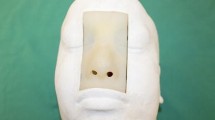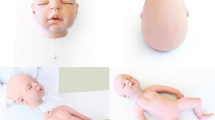Abstract
Introduction
Practicing skull base approaches on cadavers affords the surgeon a chance to learn complex anatomical relationships and to practice surgical skills. However, there are ethical or legal problems in obtaining cadaver material in some countries. In addition, there is always risk of transmitting infections with cadaveric material. In order to get around these problems, we created a whole skull model which reproduces the detailed anatomy within the skull base using a selective laser sintering (SLS) technique.
Materials and methods
The first author’s head was scanned using multidetector-row computed tomography. The data were reconstructed and converted into the standard triangulation language file system. Powdered material comprised of polyamide nylon and glass beads was laser-sintered in accord with the data derived from the head CT. The model was dissected under a surgical microscope using a high-speed drill, suction, and other surgical instruments.
Results and discussion
The appearance of both inner and outer cranial surfaces, including sutures, foramens, fissures, and protrusions, were clearly demonstrated. The artificial mastoid did not melt from the heat of the drill when a mastoidectomy was performed. The anatomical structures inside the mastoid and of paranasal sinuses were accurately reproduced in the model.
Conclusion
The model created using SLS should be very useful for the teaching skull base approaches avoiding the ethical, legal, and infection problems inherent in cadavers.




Similar content being viewed by others
References
Aung SC, Tan BK, Foo CL, Lee ST (1999) Selective laser sintering: application of a rapid prototyping method in craniomaxillofacial reconstructive surgery. Ann Acad Med Singapore 28:739–743
Berry E, Brown JM, Connell M, Craven CM, Efford ND, Radjenovic A, Smith MA (1997) Preliminary experience with medical applications of rapid prototyping by selective laser sintering. Med Eng Phys 19:90–96
Berry E, Marsden A, Dalgarno KW, Kessel D, Scott DJ (2002) Flexible tubular replicas of abdominal aortic aneurysms. Proc Inst Mech Eng 216:211–214
Henry JA, O'Sullivan G, Pandit AS (2007) Using computed tomography scans to develop an ex-vivo gastric model. World J Gastroenterol 13:1372–1377
Hiramatsu H, Tokashiki R, Yamaguchi H, Suzuki M, Ono H (2006) Three-dimensional laryngeal model for planning of laryngeal framework surgery. Acta Otolaryngol 126:515–520
Hurson C, Tansey A, O'Donnchadha B, Nicholson P, Rice J, McElwain J (2007) Rapid prototyping in the assessment, classification and preoperative planning of acetabular fractures. Injury 38:1158–1162
Begall K, Vorwerk U (1998) Artificial petrous bone produced by stereolithography for microsurgical dissecting exercises. ORL J Otorhinolaryngol Relat Spec 60:241–245
Kermer C, Rasse M, Lagogiannis G, Undt G, Wagner A, Millesi W (1998) Colour stereolithography for planning complex maxillofacial tumour surgery. J Cranio-Maxillo-Facial Surg 26:360–362
Suzuki M, Ogawa Y, Kawano A, Hagiwara A, Yamaguchi H, Ono H (2004) Rapid prototyping of temporal bone for surgical training and medical education. Acta Otolaryngol 124:400–402
Levy RA, Guduri S, Crawford RH (1994) Preliminary experience with selective laser sintering models of the human temporal bone. AJNR Am J Neuroradiol 15:473–477
Suzuki M, Hagiwara A, Ogawa Y, Ono H (2007) Rapid-prototyped temporal bone and inner-ear models replicated by adjusting computed tomography thresholds. J Laryngol Otol 121:1025–1028
Author information
Authors and Affiliations
Corresponding author
Additional information
Comments
This is an interesting paper demonstrating the use of selective laser sintering to develop a skull model useful for skull base lab educational experience. While this has been applied in otology for this purpose, this paper educates the neurosurgical readership: the precise composition of the material that will simulate drilling of the skull base in a laboratory experience. This is a useful model to simulate skull base anatomy and drilling, especially important in those regions of the world where access to cadaveric specimens is limited. I commend the authors for bringing this to our attention.
W.T. Couldwell
Utah, USA
This is an interesting report describing the development of a whole skull model reproducing the anatomic features of the cranial base. The sophisticated technology adopted produced detailed and realistic modeling of the relevant bony structures. There are many practical limitations in some countries in obtaining cadaveric specimen for practicing skull base approaches, which is important not only for teaching residents but also for already trained neurosurgeons. This paper adds another useful piece of information on the potential advantages of new educational tools in neurosurgical training and clinical practice.
Nevertheless, at the state of the art, from the strictly educational point of view, this technique cannot exactly reproduce the unpredictability of actual surgical fields; neither can substitute the visual and tactile feedback of handling living brain and dissecting around the neurovascular structures.
Domenico d'Avella
Luca Denaro
Padova, Italy
Rights and permissions
About this article
Cite this article
Wanibuchi, M., Ohtaki, M., Fukushima, T. et al. Skull base training and education using an artificial skull model created by selective laser sintering. Acta Neurochir 152, 1055–1060 (2010). https://doi.org/10.1007/s00701-010-0624-7
Received:
Accepted:
Published:
Issue Date:
DOI: https://doi.org/10.1007/s00701-010-0624-7




